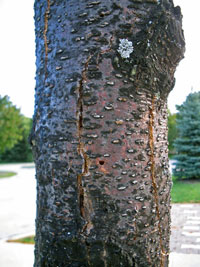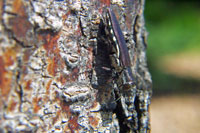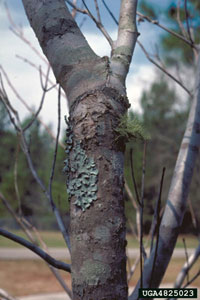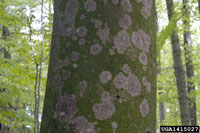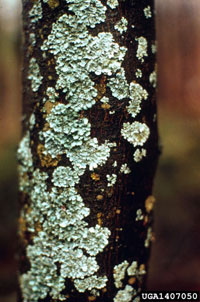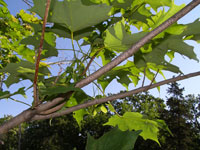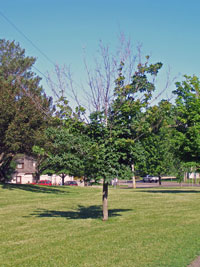Extension > Garden > Diagnose a problem > What's wrong with my plant? > Deciduous > Honeylocust > Unusually colored bark on branch or trunk
Honeylocust > Branches > Unusually colored bark on branch or trunk
1 of 3
Honeylocust borer
Agrilus difficilis
- Wet spots due to sap-stains on bark around infestation sites
- Removal of bark reveals frass filled galleries
- “D” shaped exit holes found in declining branches
- Adults are 5/16- ½ inch long, bullet-shaped with characteristic whitish to yellowish bands on abdomen
- Adults make notches along leaf margins while feeding
- More information on Honeylocust borer
2 of 3
Lichens
Several species
- Colorful patches on the bark of trunk and/or branches
- Can be wrinkled, in scalloped sheets, lace-like pads, bushy tufts, paint-like spots or splashes
- Forms can be flat against the bark surface or raised in leaf-like lobes, finger-like or hairy projections
- Colors may be shades of gray, green, blue, yellow, orange, or red
- Lichens do not harm trees or shrubs and no management is necessary
- More information on Lichens
3 of 3
Coral spot canker
Nectria cinnabarina
- Sunken dark brown area on branch that is often cracked or has a ridge at the edge
- Raised cushion-like bumps on affected branches, may be cream to orange or red, turn black with age
- Dead branches and twigs, often first observed in early spring when no leaves form
- Or, wilting soon after leaves emerge in spring
- Common on trees stressed by drought, recent transplant or other factors
- More information on Coral spot canker



